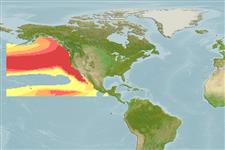Common names from other countries
>
Carangiformes (Jacks) >
Carangidae (Jacks and pompanos) > Caranginae
Etymology: Trachurus: Greek, trachys, -eia, -ys = rough + Greek, oura = tail (Ref. 45335); symmetricus: From symmetricus which means regularly formed - referring to the rough tail (Ref. 6885).
More on author: Ayres.
Environment: milieu / climate zone / depth range / distribution range
Sinh thái học
Biển; Ở đại duơng, biển (Ref. 51243); Mức độ sâu 0 - 400 m. Subtropical; 65°N - 13°N
Eastern Pacific: southeastern Alaska to southern Baja California, Mexico and the Gulf of California; reported from Acapulco in Mexico and the Galapagos Islands.
Bộ gần gũi / Khối lượng (Trọng lượng) / Age
Maturity: Lm ? range ? - 31 cm
Max length : 81.0 cm TL con đực/không giới tính; (Ref. 2850); common length : 55.0 cm TL con đực/không giới tính; (Ref. 9283); Tuổi cực đại được báo cáo: 30 các năm (Ref. 766)
Các tia vây lưng cứng (tổng cộng) : 8 - 9; Các vây lưng mềm (tổng cộng) : 28 - 38; Tia cứng vây hậu môn: 1 - 2; Tia mềm vây hậu môn: 22 - 33; Động vật có xương sống: 23 - 25. Small specimens may have an additional forward-directed spine at first dorsal origin (embedded in larger specimens).
Adults are often found offshore, up to 500 miles from the coast (Ref. 9283). They form large schools (Ref. 2850). Young frequently occur in school near kelp and under piers (Ref. 2850). They feed mainly on small crustaceans and fish larvae (Ref. 9283). Large individuals often move inshore and north in the summer (Ref. 2850). Marketed fresh, smoked, canned and frozen; eaten fried, broiled and baked (Ref. 9988).
Eschmeyer, W.N., E.S. Herald and H. Hammann, 1983. A field guide to Pacific coast fishes of North America. Boston (MA, USA): Houghton Mifflin Company. xii+336 p. (Ref. 2850)
IUCN Red List Status (Ref. 130435)
CITES (Ref. 128078)
Not Evaluated
Threat to humans
Harmless
Human uses
Warning: mysqli::__construct(): (HY000/1040): Too many connections in /var/www/html/includes/func_getlabel.php on line 46
Can't connect to MySQL database (fbapp). Errorcode: Too many connections
